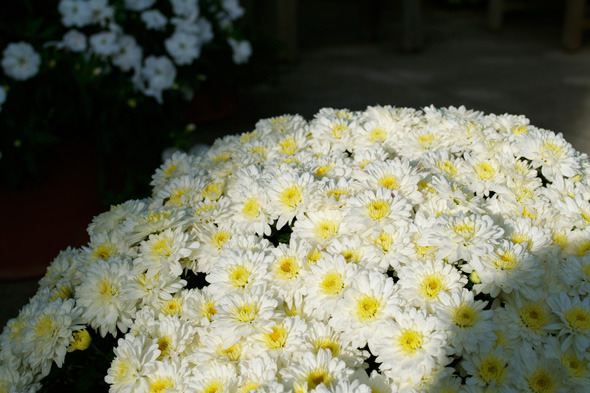It’s been a busy month with fall cleanup and prep for winter. As the gardens grow, so do the chores that accompany them. I’m happy to say that I’m ahead of schedule by a long shot according to my past blog entries. As I was revisiting them, it suddenly occurred to me that my blog is 1 year old. Our first anniversary!
My blog started out as mere curiosity but is now inherently vital as I’ve slowly given myself over to gardening. I don’t fancy myself a writer. Not even a little. I’m envious of my blogging peers like Kevin at Nitty Gritty Dirt Man and Lee at Lee May’s Gardening Life, who seem to have such a way with words. I thoroughly enjoy their blogs and marvel at the emotions that they are able to pull out of me as I read them.
Anyway– to commemorate this anniversary, I thought I’d give you a little tour of my office and talk about my process.

I use two of the three rooms on the third floor in our early 1920s house. Most of my writing happens in the room facing west. It receives very little filtered light which is perfect for my displays. My partner Michael is a CPA and occupies the largest room which faces north. It has a gorgeous view of the back lawn and creek. A little jealous.
I do all my work on a MacBook Pro (laptop) combined with an LED display (large screen) for detail work. If you’re thinking “boy this is fancy setup for blogging,” you’re absolutely right, but I do graphic design work as well. I specialize in print media for select clients.
The glass top Parsons style desk is bare right now, but there is usually a camera and a couple of books on it at any given time. The little file cabinet beneath holds supplies and files. There are way too many garden catalogs in there!

My inbox looks pretty good right now, but trust me, it get’s out of control pretty fast. The Farrow & Ball brochures are for color research. I’m contemplating an interior paint job for the first floor this winter.

To my right is a bank of printers- a black & white laser plus two inkjet printers. The largest inkjet can print 13 x 19 inches of photo quality prints.

To the left of my desk are two small bookshelves which I consider ‘rotating’ bookshelves. Because I write many instructional posts, I keep several books and journals at hand for research and fact checking. I also keep my Purdue Extension Master Gardener handbooks nearby.
I love my sturdy green binders with the finger hole cutouts. The binders are by Naked Binder. These 3-ring binders keep my paper documents well organized and at hand so I can grab-and-go for meetings. Each binder is dedicated to a specific garden topic or organization that I am affiliated with.


Here are a few of the titles that I’m currently referencing the most. At any given time, I may swap these out for different ones. What you don’t see are the shelves in the other rooms that are overflowing with garden, art, and design books. The top surface of the shelves is dedicated to new favorites and file folders for current projects. Kind of obsessed with Piet Oudolf right now.

The wall opposite of my desk is used for storage. The lateral file holds more files and supplies. I’m trying to train myself to not let it be a catchall. The stuff on top is a pile of plant tags that need to be filed away. The little white box on the left is Apple’s AirPort Extreme which provides high-speed wireless throughout the house.

This chair doesn’t see much action in summer because I’m usually outside all day. However, in winter I make good use of it. This nook is perfect for catching up on periodicals, garden catalogs or a book. The small windows offer a glimpse of the current weather conditions and catch the elusive rays of late afternoon sun during the cold weather months.

I use many software programs for my Hortus|5 posts. Most stories utilize a combination of Microsoft Word, Apple iPhoto, Adobe Photoshop, Adobe Illustrator, and finally Squarespace. But before any work happens, I can tell you this- the photos come first. I follow this mantra: Shoot now, think later. I’m often inspired by an event or something I see and then write about it. Rarely do I compose a story and then support it with visuals. I use a Nikon D3100 for nearly all of my photos. My iPhone is my second camera.

I typically compose the entire story in Microsoft Word first. I try really hard to get it ‘right’ in Word before anything else happens. Sometimes, if the post is a quicky, I forgo Word. As I write, the supporting images are running through my head. Often, I have iPhoto up alongside Word so I can see the images as I write.

Next, I make the final image selections and do simple edits in iPhoto such as rotating, and cropping. Then I open all the final images in Photoshop and optimize them for Web use. This process literally downsizes the file size to my specifications while retaining as much detail as possible. In the end, this allows the images to load faster and since you never know what device your blog will be viewed on (phone, tablet or monitor), speed is important. Many blog platforms have storage limits- that’s another reason to reduce file size. Last, I rename and save the images in JPEG format. I add my blog name as part of the image title. Example: juniper_hortus5.jpg
If I need special graphics or charts in my story, I try to create them myself in a drawing program. An example of this would be in my How To Plant A Tree post. All the tree and text graphics were created in Illustrator.

Finally, when all the components are together, I launch Squarespace and post a new entry. The editing window in Squarespace is similar to other blog platforms. I jump back and forth between editing and preview to see how it’s looking. Even though I devote so much time to writing in Word, inevitably there are edits and tweaks that happen once I see the post in its final form. I may even change images altogether. I think one of the most difficult challenges in writing is putting yourself in place of the reader- looking at it objectively. Since many of my posts include detailed information, I spend a great deal of time checking facts, syntax and sequence prior to publishing. I liken it to a recipe.
I have discovered that it’s best for me to complete a post and walk away from it for an extended period of time before publishing it. I catch more mistakes that way, like misspellings and words that have been left out. When all is good, I check the ‘publish’ box. Still, I’m so fastidious that I keep reading and tweaking until midnight hoping to catch any mistakes before Feedburner sends out the email notification to my subscribers. Of course, the beauty of online publishing is that no mistake is final- you can always correct it on-the-fly. I have found mistakes in posts that are months old!

I chose Squarespace because of it’s elegant format. I didn’t want my blog to look too similar to anyone else’s and Squarespace offers many customizing options. One thing to note is that Squarespace is not free, but it’s stable and the support team is excellent! Alexander Pincus from Bureau V is pretty much responsible for introducing me to Squarespace and helped me set up my site. I handle it on my own now, but I’d like to thank him for his insight and patience when I was just starting out.
So, in a nutshell, that’s how I do it. I wonder how other bloggers do it? I’d love to hear about your writing process if you blog. I find it’s a great medium for sharing ideas and how-to advice. Gardening is an experiential endeavor. You could never fully understand it by simply reading books and websites, but I hope my blog sheds some light on this very diverse topic. Onward and Upward!














































































































